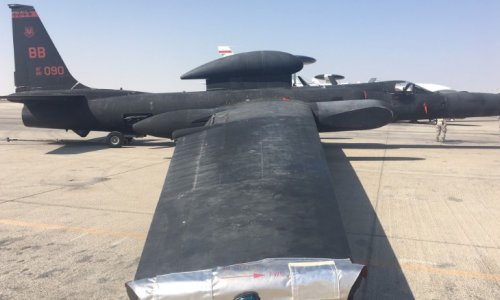U2 'Dragonlady' pilots spy on ISIS from the edge of space
Getting dressed for a combat mission in a U2 "Dragonlady" reconnaissance plane looks almost like the preparations for a space flight, the pilot in a yellow compression suit wearing a massive white helmet.
The suits need to be cooled the entire time, otherwise the pilots would die of heat exhaustion in a matter of minutes, but they are necessary to protect the crew members as they fly surveillance missions over Iraq and Syria at more than 70,000 feet scoping out ISIS targets.
The US Air Force gave CNN rare access to U2 crews flying out of a secret location in the Middle East. We can only identify the pilots by their rank, first name and their call sign.
The pilot getting suited up was named Capt. Steven. His call sign is "Meathead." He was brought to the plane in a bus similar to those that bring astronauts to their spacecraft. He was connected to a mobile cooling unit the entire time. Dozens of ground personnel were readying the U2 jet for a 10-hour mission.

The U2 can climb to well over 70,000 feet, making it an important asset in the effort to find and destroy senior ISIS fighters.

The fights suits worn by U2 fliers resemble astronauts' space space suits.

The "Dragonlady" is a Cold War-era plane that has been flying since the 1950s.

The compression suits are cooled to keep the pilots from suffering heat exhaustion.

U2s are difficult to land, with landing gear aligned like the wheel of a bicycle.

The pilots fly missions of about 10 hours.

The flight suits protect their wearer at high altitude.

The U2 is just one tool in used in airborne surveillance aimed at destroying ISIS.
"You do things to keep your mind busy," Capt. Steven said, referring to the toll the long hours sitting in the cockpit take on them. "The radios are constantly going, there's constant communications with guys on the ground. So it keeps you busy."
The "Dragonlady" lifted off soon after, quickly climbing into the Middle Eastern sun. The U2 is built for altitude. It can climb to well over 70,000 feet, making it an important asset in the effort to find and destroy senior ISIS fighters, safe houses and battle positions.
"With the U2 we're able to get out there, find those guys and track them," said another pilot, Maj. Matt. "Then we get that information back to the fighters and bombers, so that way when they go out there they've got the best intel, the best information about where they are and can do what needs to be done."
The U2 "Dragonlady" is a Cold War-era plane. It's been flying since the 1950s. But the planes have been modernized with new sensors and cameras, making them an important asset in the intelligence war against ISIS. But they are by far not the only ones. Drones also play a major role. From the massive Global Hawk that can stay in the air well over 24 hours to the smaller predator and reaper unmanned aerial vehicles, all these platforms contribute to what is a gigantic airborne surveillance aimed at degrading and ultimately destroying ISIS.
"I am seeing continuous progress," said Col. Paul Birch, the head of the 380th Expeditionary Operations Group. "There's progress each day. From reports about what's happening to ISIS on the ground I know that we are having an absolutely critical impact."
But despite the many surveillance assets and the major firepower of coalition aircraft in the skies over Iraq and Syria, ISIS remains a powerful and elusive group, offering stiff resistance to Iraqi and Kurdish forces as they try to storm the terror group's biggest stronghold, Mosul. Iraqi leaders have acknowledged it could be months before Iraq's second largest city might be liberated.
That means many more missions for the crews of the U2 "Dragonlady." After about 10 hours we were on hand when Capt. Steve came in to land. The U2 is a very difficult aircraft to bring to the ground. Its landing gear is aligned like the wheel of a bicycle. Keeping one from running off the runway requires great skill and the help of a second pilot trailing the jet down the runway in a chase car and keeping radio contact.
Peeling himself out of the plane, Capt. Steven was happy to leave the confines of the small cockpit and satisfied with the support he was able to provide forces fighting on the ground.
"The things that we can do while we are up there, as well as how often we are up there. Thanks to our maintenance guys we are constantly up in the air providing that support for those who need it most," he said.
And it looks like the demand for the U2 missions won't go away anytime soon, as the international coalition continues to ramp up the pressure and the firepower, trying to destroy the network for good.
www.ann.az
Follow us !






